Don't just extend without doing a careful layout. The non-parallel configuration behaves differently than the parallel Garrard, with different lengths a la the Thales and Van Eps. Fascinating.
The Garrard isn't parallel either, it just looks that way in certain photos. The geometry of these things isn't hard to work out, I explained it a few pages back.
the "drag arm" essentially has one end sit into a cup, and the other a small cartridge type bearing.
I always felt the Van Eps and Thales Simplicity (or any dual wand tonearm) can be benefited from using two unipivot bearings at the arm-base pivots, one for each wand. This type or arms begs for unipivot bearings. As long as the height of the bearing tips is equal, there will be no azimuth rocking like a unipivot tonearm because the two wands are supporting each other. It will simplify things a great deal.
Of course, then the Thales will not be able to show off its tiny precision Swiss bearings, which attracts the high rollers. But I prefer true simplicity.
.
geometry and such
Mark,
Why does there always seem to be folks warning not to "just" do something, when it is the "doing" that is the essence of learning? Of course you have to do the geo/trig to ensure that you won't be going backwards in terms of performance.
Really I guess I could just make a pair of uni-pivot arms connected by a cross-member that would hold the cartridge. An adjuster would be required to allow one arm to pivot about the other and then be locked down for fine tuning.
Mark,
And very easy to do if you actually have one to look at (as I do). As I stated, I think a new headshell or a modified stock Garrard "carrier" is easy enough to figure out.The Garrard isn't parallel either, it just looks that way in certain photos. The geometry of these things isn't hard to work out, I explained it a few pages back.
Why does there always seem to be folks warning not to "just" do something, when it is the "doing" that is the essence of learning? Of course you have to do the geo/trig to ensure that you won't be going backwards in terms of performance.
Really I guess I could just make a pair of uni-pivot arms connected by a cross-member that would hold the cartridge. An adjuster would be required to allow one arm to pivot about the other and then be locked down for fine tuning.
Why does there always seem to be folks warning not to "just" do something, when it is the "doing" that is the essence of learning? Of course you have to do the geo/trig to ensure that you won't be going backwards in terms of performance.
I don't think Phivates and Mark are trying discourage you to experiment. Just a fair warning. But, admittedly, I have seen a lot of that type of warnings you mentioned in many forums that totally defeats the purpose of the "DIY" spirit.
Nanook: "Really I guess I could just make a pair of uni-pivot arms connected by a cross-member that would hold the cartridge. An adjuster would be required to allow one arm to pivot about the other and then be locked down for fine tuning."
That's not a bad idea. A Pair of unipivot arms are certainly easier to make than the prohibitively complex Van Eps arm... minus the cool factor, of course.
I still think the easiest arm to make is Mysterious Stringed arm I mentioned earlier. Just use a conventional pivot arm and add a pivot or ball bearing on the headshell and control by two strings and you're good to go.
I think using a conventional pivot arm with detachable headshell is even easier and totally reversible. Arms like Jelco and Graham Robin are good candidates. I would prefer a straight armpipe than a curved one, hence the Robin.
An externally hosted image should be here but it was not working when we last tested it.
An externally hosted image should be here but it was not working when we last tested it.
.
What could be the interest to design or build a ~0° angle error turntable arm, if this one is curved, and so will suffer the centipede force problem (made worse by increasing the number of pivots) witch *is* the major source of distortion and, so, the first to fight again ?
Strait arms solutions solve all the geometrical problems. I would forget any other track concerning geometry.
And, because servo electronics solve most of the mechanical problems (frictions) in a very simple, elegant and economical way, it seems to me it is the only good way to consider.
Strait arms solutions solve all the geometrical problems. I would forget any other track concerning geometry.
And, because servo electronics solve most of the mechanical problems (frictions) in a very simple, elegant and economical way, it seems to me it is the only good way to consider.
Last edited:
That seems to amount to "what I made works so don't try to improve it".And, because servo electronics solve most of the mechanical problems (frictions) in a very simple, elegant and economical way, it seems to me it is the only good way to consider.
Not the spirit here.
Last edited:
Just the indispensable 'study of the value' that should precede any study, the only way to get a chance to find a clever solution at a problem.That seems to amount to "what I made works so don't try to improve it".
Not the spirit here.
in the same spirit that this sentence of stevieg's Dad: "a collection of solutions looking for a problem"...
CD recorders/players face the same problem, and they all solve-it that way... For good industrial reasons... Intelligence before "spirit"...
in the same spirit that this sentence of stevieg's Dad: "a collection of solutions looking for a problem"...
CD recorders/players face the same problem, and they all solve-it that way... For good industrial reasons... Intelligence before "spirit"...
Maybe this entire thread is just a "collection of solutions looking for a problem". Does that discourage all of us less intelligent folks here? Certainly not me!
What could be the interest to design or build a ~0° angle error turntable arm, if this one is curved, and so will suffer the centipede force problem (made worse by increasing the number of pivots) witch *is* the major source of distortion and, so, the first to fight again ?
Strait arms solutions solve all the geometrical problems. I would forget any other track concerning geometry.
And, because servo electronics solve most of the mechanical problems (frictions) in a very simple, elegant and economical way, it seems to me it is the only good way to consider.
You obviously did not read my post closely. I did list a straight arm, the Graham Robin. And the reason I posted the curved Jelco arm is that there are extremely few straight arm with DETACHABLE HEADSHELL, since standardized SME style headshell are inherently straight body so the offset angle has to be curved at the armpipe. Yes, I would prefer it to be straight but the curved Jelco is one of the most common midpriced tonearm in the market and even better in the used market. After all this is a DIY forum so I have to consider budget in mind. The Jelco is the same as the ubiquitous Sumiko MMT arm that was very popular in the 80's. Since it has a removable headshell, just get an extra headshell for experiment is something more affordable in case something goes wrong and ruin a stock arm. The key is that it's reversible. The only other straight arm with detachable headshell I can think of is the tonearm on the Kenwood KD-770D integrated turntable but you cannot remove the arm from the table without wrecking the whole thing. I own couple units so I might use that for experiment. I would recommend a Rega RB250 or RB300 if they have detachable headshell... Again, a straight armwand is preferred but a curved one is not the end of the world and works the same way. A straight and curved arm both will suffer from skating force problem anyway regard of their shape. Let's just accept the fact that skating force exist in these arms and deal with it.
The main reason I mention these conventional pivot arm is that they are readily available and not too expensive. Adding a pivot with some precision bearing on the headshell is affordable to us budget minded audiophiles. More importantly, with detachable headshell, it's reversible! Adding two strings as bearings are not that expensive either and is easy to alignment for accurate geometry. The arm still functions like a normal arm with antiskating adjustment intact and since there's no overhang skating force will be less. I readily accept the complexity of the Van Eps arm, Thales Simplicity, or even the Garrard Zero, is not for me. But we can still learn a few tricks here and there and try to improve it. The maker of that stringed tonearm has the right spirit and consummated in one of the cleverest idea I've seen. I applaud that.
Let's look at the solution you proposed. It would require a motor, a sensor system and electronics, a power supply, a linear bearing track, etc... And I have no in depth knowledge of any of them. What kind of motor I should use, what is a good sensor to use, what type of feedback servo, what kind of linear bearing, what is the tolerance, etc.... After all that, I still don't know where to begin and when you add the cost of these items to the whole project, one might just heed your advice and buy a CD player. Compare to a conventional pivot tonearm with additional pivots and couple extra strings, you honestly think your solution will cost less and be simpler to make? By the way, that Dereneville turntable by AVDesignhaus is putting your concept over the top. Not exactly your DIY project for the weekend warriors either.
Stevieg's dad maybe right but he didn't say he wasn't having fun solving those problems and, hey, at least a Vincent motorcycle is pretty cool looking.
P.S. Nanook, you should forget about your Garrard Zero 100 project and just buy a CD player.
.
Sorry, but i do not understand. This is not a *strait arm*:The only other straight arm with detachable headshell I can think of is the tonearm on the Kenwood KD-770D integrated turntable.
Looking at your image, it is obvious that the headshell makes an angle with the arm, so the centipede force is there.
What i called "strait arm" is an arm where the cantilever supporting the diamond is aligned with the pivot.
The form of the arm between the headshell and the pivot is just a matter of design. "S" arms are just the worse response in matter of rigidity, resonance, and weight. The form of tha arm itself changes nothing in geometry and centipede force, as long those two pieces (head and pivot) stay at the same place.

My original remark was not intended to be negative, aggressive or discouraging.
To answer your remarks about this thread, it is a *very* interesting thread on a historical point of view, and i had discovered a lot of thinks and makers. Very nice to look at all those mechanical pieces of art and all those imaginative solutions.
But it is just like watchmaking.
You can admire or love Rolex. Those prestigious watch will never be as precise as a cheap Quartz chronometer. All the question is what you are looking for:
Show-off, art or time precision ?
Mechanical laws stay the same:
-A: One pivot with the same lever arm and weight on it will produce less friction than two or more pivots.
-B: The only way to get rid of error angle distortion is to have *no* error angle.
-C: the only way to have no distortion produced by centipede force is to align the cantilever supporting the diamond with the axis of the arm.
The only solution i know witch fully satisfy those 3 points are radial arms with a servo motor and error detection.
If you thing electronic is more complicated than mechanic, it is just *your* point of view, it is just cheaper and easier in real world, and stay the best response because you can make your arm as short (rigid and light) as you want, and absolutely free: only one pivot on the two axes. And the energy necessary to move the arm or change his geometry will not be taken on the diamond side, but powered by a motor.
Now, you can concentrate on the last remaining problem: the torsion forces of the modulation cable.
Playing with liquid gallium contacts, hf , magnetic or light transmission...
Or forget about all those museum's old analog problems and have a look to the Digital solutions offered by our century to record, preserve and reproduce music . ...Thousand time better... Not so good looking...
To Esperado. Sure, a smart engineer with good background in electronics will be able to create perfectly tracking electronically guided arm (there are already a lot of them), possibly even a better one, than most of mechanical ones. However, mechanically inclined hobbyists here are trying to achieve that task mechanically, for a reasonable cost, and sonically it supposed to be above the average level of industrial items, that is pretty realistic task.
And let's have some fun, besides...
And let's have some fun, besides...
Last edited:
Or forget about all those museum's old analog problems and have a look to the Digital solutions offered by our century to record, preserve and reproduce music . ...Thousand time better... Not so good looking...
Thanks for the pointers. But... hmm... last time I checked, this forum is for "analogue source." Am I right or am I missing something here?
Here is another fun item: "Mag-Lev/Hydraulic Vertical Piston Linear Tonearm" by SimplyPhysics. On their web-page, here's how they describe this prototype tonearm:
The turntable looks interesting too but let's just focus on the arm. It's a purely mechanical design, with NO air-bearing, no motor, no sensor, no electronics, and no power supply. Extremely low mass, low friction...almost sounds like a mechanical ideal... but will the implementing of magnet affect the cartridge by the magnetic force since the cartridge body is so close to the magnetic rail and that magnetic "piston" bearing. The basic question is that are the magnets well shielded? How rigid is that thin cushion of magnetic force between the maglev rail and the arm assembly--much the same concern with air-bearing? And how well does the "vertical hydraulic piston" bearing work in terms of friction and movement? It's an intriguing design and we have to wait and see if this prototype will actually work when it comes out in the market. I have my doubts because so far all I see is just a drawing. Another concern is how is VTA or, more importantly, SRA is adjusted since there's no "teeter-tottering" and only vertical motion, I hope there's something at the headshell area that allows for the SRA, stylus rake angle.
If this type of pistonic bearing works, it can be applied to many other designs for good use since it eliminates the vertical bearing at the armbase. I can imagine using that on a Dynavector tonearm with its "split plane" design. Or the below arm...
Now that weird arm above reminds me of the Vestigal tonearm:
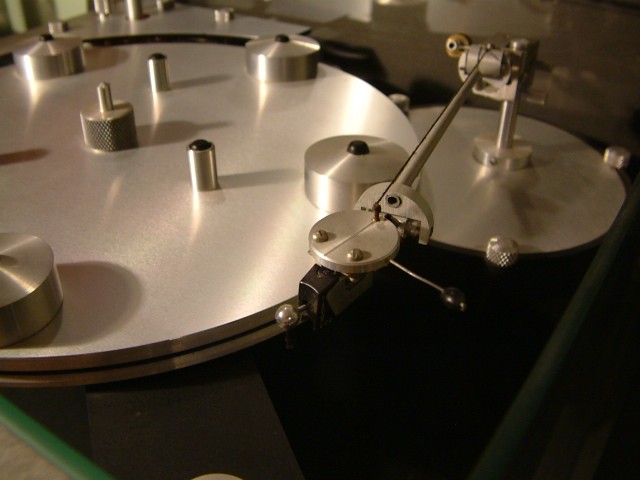
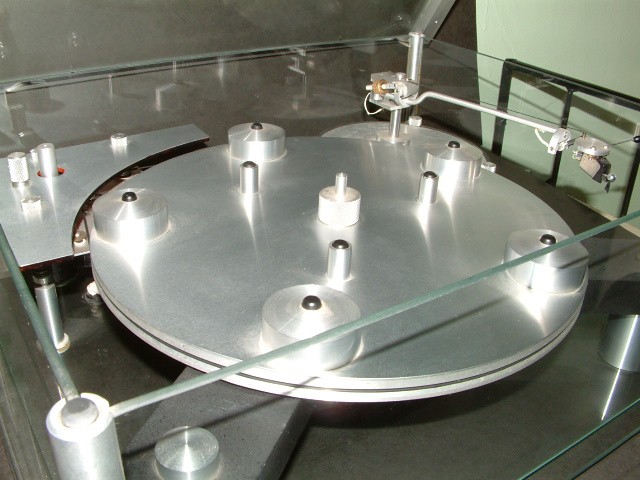
Another tonearm that inhibits vertical motion at the base is the Loci tonearm:
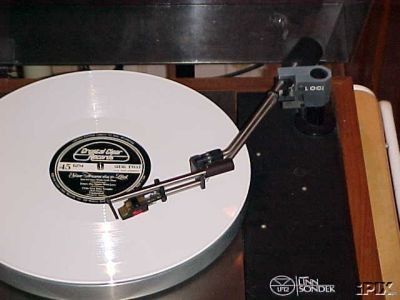

.
Work is underway on the nextgen of innovation, a maglev linear tracking & "armless" design (pictured below). It's sans an “arm” tube or wand, utilizing a vertical hydraulic piston with internal magnetic dampening. The stylus cannot leave perfect tangent & the piston is sans relative mass, only tracking force. It cannot “teeter-totter" as in pivoting or linear tracking "armed" designs. No other design maintains perfect vertical tangent and azimuth alignment, and it's linear maglev!
An externally hosted image should be here but it was not working when we last tested it.
The turntable looks interesting too but let's just focus on the arm. It's a purely mechanical design, with NO air-bearing, no motor, no sensor, no electronics, and no power supply. Extremely low mass, low friction...almost sounds like a mechanical ideal... but will the implementing of magnet affect the cartridge by the magnetic force since the cartridge body is so close to the magnetic rail and that magnetic "piston" bearing. The basic question is that are the magnets well shielded? How rigid is that thin cushion of magnetic force between the maglev rail and the arm assembly--much the same concern with air-bearing? And how well does the "vertical hydraulic piston" bearing work in terms of friction and movement? It's an intriguing design and we have to wait and see if this prototype will actually work when it comes out in the market. I have my doubts because so far all I see is just a drawing. Another concern is how is VTA or, more importantly, SRA is adjusted since there's no "teeter-tottering" and only vertical motion, I hope there's something at the headshell area that allows for the SRA, stylus rake angle.
If this type of pistonic bearing works, it can be applied to many other designs for good use since it eliminates the vertical bearing at the armbase. I can imagine using that on a Dynavector tonearm with its "split plane" design. Or the below arm...
An externally hosted image should be here but it was not working when we last tested it.
An externally hosted image should be here but it was not working when we last tested it.
Now that weird arm above reminds me of the Vestigal tonearm:


Another tonearm that inhibits vertical motion at the base is the Loci tonearm:


.
Last edited:
My old Dad used to say that the Vincent motorcycle was a collection of solutions looking for a problem.
My Dad's point was that you can overengineer to the point of unuseabilty/unintelligibility. My problem with the extremely complex behemoth approach is that if you just want to spin a few tunes on the turntable, it should be a relatively simple activity. I think turntable are similar to bicycles - perfection is easy to design; trouble is, you then have to fit a human in there...
Nanook's twin single pivot idea has merits; the fewer the bearing the fewer things to rattle. Also the wire guided swinging headshell.
Still loving this thread, but have a need to spin some Warren Zevon. Bye!
Cheers Steve
twin pivot approach...
Even simpler (although not a tangential pivoting tonearm at all!) is my 219, which is about as dumb stupid easy as you can get.Nanook's twin single pivot idea has merits; the fewer the bearing the fewer things to rattle. Also the wire guided swinging headshell.
And in this hobby what's the point if we don't actually love listening to music!Still loving this thread, but have a need to spin some Warren Zevon. Bye!
BJ tonearm
Some rare photos of the Burne-Jones tonearm.
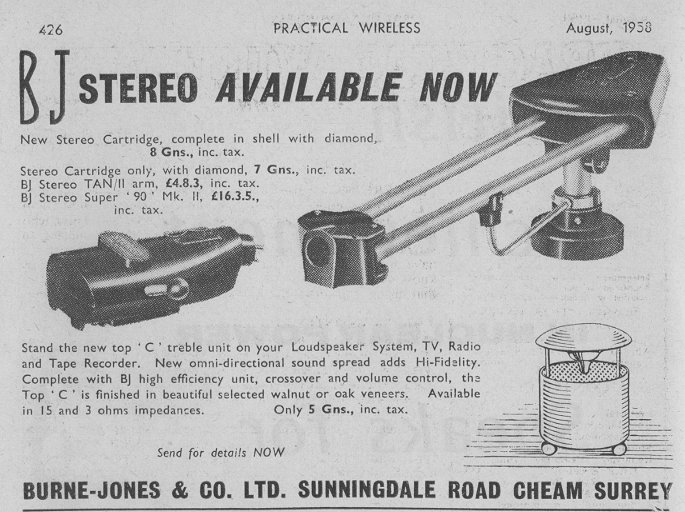



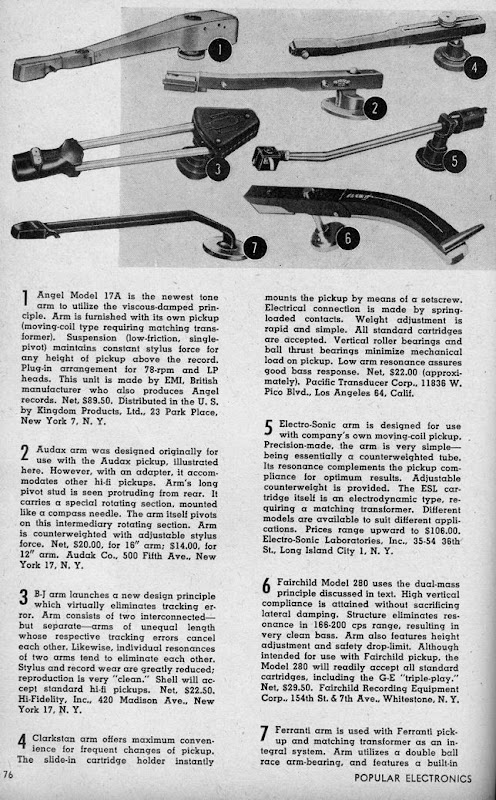

Some rare photos of the Burne-Jones tonearm.
An externally hosted image should be here but it was not working when we last tested it.
An externally hosted image should be here but it was not working when we last tested it.
An externally hosted image should be here but it was not working when we last tested it.





still thinking of dual pivots...
As I have stated all along in this thread and others, when one has to engineer a solution, it is usually the simplest version that comes out ahead. Not always (there are always creative means to an end), but usually.
The simplest articulating tonearm that could offer near tangential tracking is most probably the Thales arms or those that use the same principles (I'm sure if we look hard enough the Garrard "Zero" arm may be able to be shown that it relies on similar mathematics. The "hung cartridge as pictured in DD's last post may simply have to much play, or else adjusting the play out could be very tedious and time consuming. I was (and am) of the opinion that a cartridge should be mounted as firmly to the tonearm/headshell as possible, if for no other reason to control the geometry.
I have the pieces from 2 Sugden tonearms that could allow me to experiment with a Thales concept. The most difficult part would be making a pivoting "headshell" or mounting plate. And of course the arm would be something like 12" long as well
As I have stated all along in this thread and others, when one has to engineer a solution, it is usually the simplest version that comes out ahead. Not always (there are always creative means to an end), but usually.
The simplest articulating tonearm that could offer near tangential tracking is most probably the Thales arms or those that use the same principles (I'm sure if we look hard enough the Garrard "Zero" arm may be able to be shown that it relies on similar mathematics. The "hung cartridge as pictured in DD's last post may simply have to much play, or else adjusting the play out could be very tedious and time consuming. I was (and am) of the opinion that a cartridge should be mounted as firmly to the tonearm/headshell as possible, if for no other reason to control the geometry.
I have the pieces from 2 Sugden tonearms that could allow me to experiment with a Thales concept. The most difficult part would be making a pivoting "headshell" or mounting plate. And of course the arm would be something like 12" long as well
great thread...
I sold a Zero 100 to an elderly neighbor years ago for 20 bucks, which is what I paid for it at a thrift store. I'd like it, or another one, back because I'd like to know if it maintains a consistent offset, which the B-J definitely does not, or a progressively decreasing offset, a la Van Eps or Warden. Just missed a Garrard on CL for $35. Sorry; I'm not one of those big spenders who keep hifi going. Off to VE to see if the Garrard thread can answer this for me. My limit is $5 per item unless it's very special.
Still, that's more than $2.19.
I sold a Zero 100 to an elderly neighbor years ago for 20 bucks, which is what I paid for it at a thrift store. I'd like it, or another one, back because I'd like to know if it maintains a consistent offset, which the B-J definitely does not, or a progressively decreasing offset, a la Van Eps or Warden. Just missed a Garrard on CL for $35. Sorry; I'm not one of those big spenders who keep hifi going. Off to VE to see if the Garrard thread can answer this for me. My limit is $5 per item unless it's very special.
Still, that's more than $2.19.
The "hung" cartridge as pictured in DD's last post may simply have to much play, or else adjusting the play out could be very tedious and time consuming.
Those hanging cartridges are not to be taken seriously. I got those images from a Russian site that, even with rough translation, they are supposed to be concept prototypes that never materialized into actual products. They are merely concepts and, for me, provided visual entertainments, just like this entire thread.
I am quite aware of simplicity and structural integrity in a tonearm design but balancing that with ingenious use of geometry, bearings, and guiding mechanism is no mean feat. It sure is fun to think about them for me.
My Kenwood KD-770D turntable is broken so I might salvage its tonearm and it has a straight armwand with a detachable headshell that has an offset angle. I might replace the headshell with a conventional straight headshell that I can add a pivot with a ball bearing a la RS Labs and also come up with some guiding mechanism for quasi-tangential tracking. I am curious where this will lead to.
Nanook, I look forward to your experiment.
I sold a Zero 100 <snip> I'd like it, or another one, back because I'd like to know if it maintains a consistent offset, which the B-J definitely does not, or a progressively decreasing offset, a la Van Eps or Warden.
The concept of offset makes no sense when applied to tangential tracking tonearms.
- Home
- Source & Line
- Analogue Source
- Angling for 90° - tangential pivot tonearms